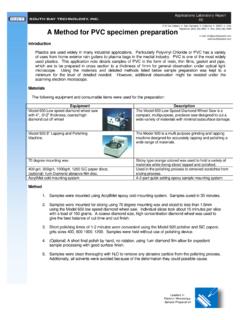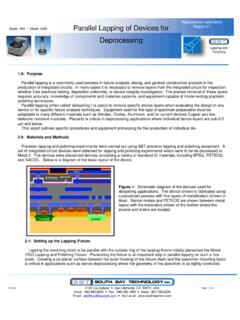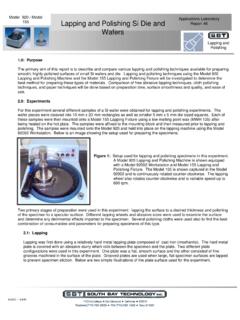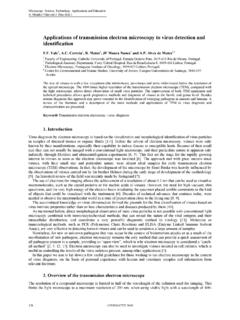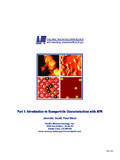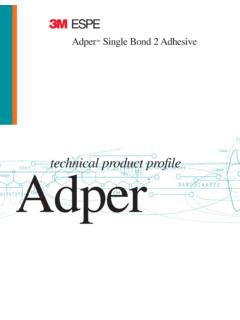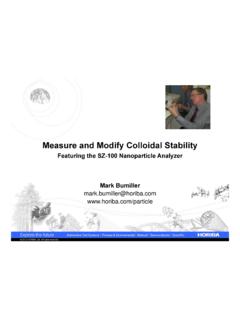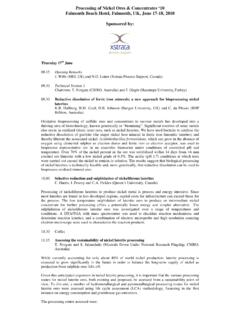Transcription of Ion Beam Sputtering: Practical Applications to Electron ...
1 1 EM Sample Preparation Applications Laboratory Report 91 Introduction Electron microscope specimens, both scanning (SEM) and transmission (TEM), often require a conductive coating applied to the sample prior to analysis. Conductive coatings serve several purposes in Electron microscopy Applications and are generally designed to minimize charging of the sample, conduct away heat from the sample during imaging, and to increase the secondary Electron yield of the sample (1). There are a wide range of instruments capable of producing these types of coatings and the selection of the instrument depends on the resolution of the microscope, the sample material, and the application for which the microscope is being utilized.
2 Some typical examples of instruments designed for producing conductive coatings are DC magnetron sputter coaters, vacuum evaporators, Electron beam evaporators, and ion beam sputtering systems. To deposit conductive coatings, sputtering instruments are often used. sputtering is a deposition process which physically removes a target material and deposits a firmly bonded coating onto the sample. The sputtering process occurs by bombarding the surface of the target material with gaseous ions (normally Ar+) under high voltage acceleration.
3 As these ions collide with the target, atoms or occasionally entire molecules of the target material are ejected and propelled against the sample, where they form a very tight bond. The resulting coating is held firmly to the surface by mechanical forces, and in some cases an alloy or chemical bond may result (2). Although both DC magnetron and ion beam systems utilize the sputtering process to produce conductive coatings, the coating quality, sample quality, and resulting image quality are dramatically different.
4 These differences in properties make the selection of the equipment critical in Electron microscopy (EM) Applications . Ion beam sputtering : Basics Ion beam sputtering utilizes an ion source to generate a relatively focused ion beam directed at the target to be sputtered. The ion source consists of a cathode and anode with a common central axis. Applying a high voltage field of 2-10 kV to the anode creates an electrostatic field inside the ion source, confining electrons around a saddle point in the center of the source. When argon gas is injected into the ion source, the high electric field causes the gas to ionize, creating a plasma inside the source region.
5 The ions are then accelerated from the anode region to the exit aperture (cathode) creating a "collimated" ion beam . The resulting ion beam impinges upon a target material and, via momentum transfer between the ion and the target, sputters this material onto the sample. Ion beam sputtered films have many advantages over other sputtering methods used in EM. Since the coating material is passed into the vapor phase by a mechanical rather than a chemical or thermal process, virtually any material can be deposited on the sample. This flexibility makes ion beam sputtered films ideal for a variety of analytical techniques used in EM.
6 Another by product of the physical sputtering process is the lack of thermal radiation presented to the sample, allowing heat sensitive samples to be processed. This is in direct contrast to magnetron methods where samples are exposed to high energy ion bombardment, Electron flux, and high temperatures. Ion beam sputtering is also a highly controllable process due to the lower deposition rates when compared with magnetron methods. This reduction in deposition rate allows for ultra-thin films to be deposited uniformly onto the sample, an advantage for high resolution SEM and various TEM Applications .
7 For these reasons ion beam sputtering is the preferred method for depositing thin film coatings onto samples for EM, especially where resolution and reduced artifacts are of primary concern. Model IBS/e The Model IBS/e is a tabletop ion beam sputter deposition system designed to utilize the advantages of ion beam sputtering and produces ultra-fine grain films of any material. The IBS/e implements a large vacuum chamber pumped by a high vacuum turbo molecular pump, producing a clean and hydrocarbon free vacuum environment.
8 A unique stage design allows a wide variety of movements during deposition or etching modes. Independent control of tilt angle, tilting speed, and sample rotation speed can all be controlled at any time during the deposition process. Sample sizes 4 (100mm) or less can be mounted into the stage and allows a wide range of Applications to be explored. Figure 1 shows an example of the Model IBS/e and the chamber configuration. Ion beam sputtering : Practical Applications to Electron Microscopy 2 EM Sample Preparation Applications Laboratory Report 91 Figure 1: The Model IBS/e Ion beam Sputter Deposition and Etching System.
9 The inside of the vacuum chamber is shown at right with the Large Area Stage (LAS) installed. Targets are mounted to the chamber lid and can hold up to 4 different target materials. Many Applications are affected by the conductive coating that is applied to the sample, the selection of which should not be taken arbitrarily. Some basic guidelines are used when selecting a target such as the desired magnification and resolution, analytical techniques used (if applicable), and sample compatibility. A basic guideline to some common targets is given in Table 1.
10 TARGET MICROSCOPE TYPE MAGNIFICATION DESCRIPTION Au, Au/Pd STANDARD SEM < 2,000 X USED FOR LOW MAGNIFICATION WORK Ir, Pt FESEM, FETEM < 200,000 X BOTH SIMILAR IN GRAIN STRUCTURE; IRIDIUM PROTECTS SAMPLES FROM beam DAMAGE BETTER Ta, Ti, W, Cr FESEM, FETEM > 200,000 X FILMS SHOW NO STRUCTURE UP TO 500,000 X; SHOW UNIFORM COVERAGE C FESEM, FETEM < 500,000 X AMORPHOUS AND INDISTINGUISHABLE FROM STANDARD C SUPPORT GRIDS; LOW BACKGROUND FOR EDX Table 1: Description of some common target materials and their Applications to Electron microscopy. Biological Applications As discussed, ion beam sputtering offers many unique features for an array of EM Applications .
